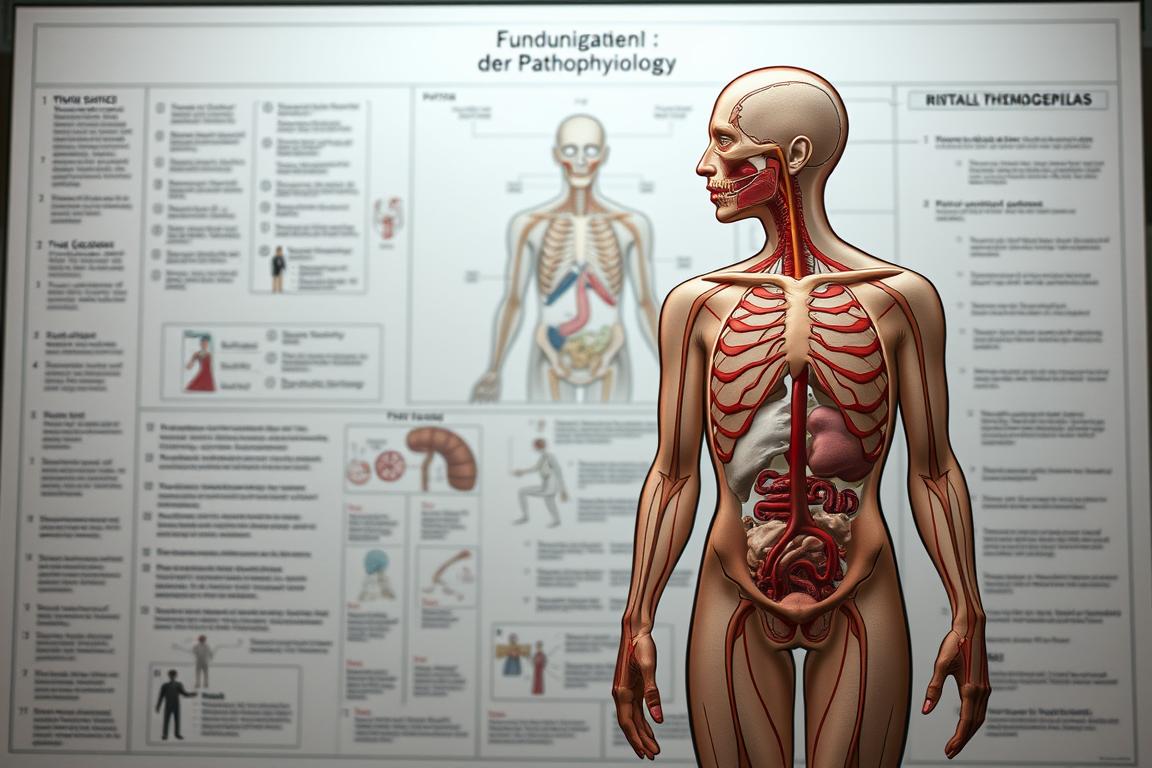The basics of pathophysiology explained
Did you know that pathophysiology studies the changes in normal physiological processes caused by disease or injury?
Pathophysiology is an indispensable field of medicine that offers profound insights into the mechanisms of disease processes. It deals with the deviations from normal functions and structures of the body that occur in disease. Understanding the basic principles of pathophysiology enables the biological effects of disease to be precisely understood and forms the basis for diagnosis and the development of effective therapies.
The link between the symptoms of a disease and its underlying biological processes means that an introduction to pathophysiology plays a central role for doctors and therapists. For example, type 2 diabetes occurs when the body no longer responds effectively to insulin, a condition known as insulin resistance. In addition, chronic obstructive pulmonary disease (COPD) can be caused by harmful environmental factors and long-term smoking.
Pathophysiology thus acts as a bridge between clinical observations and their biological explanations and is an essential part of the medical basis. It not only helps with diagnosis, but also with the development of new therapeutic approaches by deepening our understanding of the mechanisms behind disease processes.
Introduction to pathophysiology
Pathophysiology is a fascinating and complex field that refines the understanding of pathological changes in physiological processes in our body. By studying the pathomechanisms that lead to various diseases, researchers and medical professionals can develop more precise diagnostic and therapeutic approaches. These approaches are directly aimed at supporting physiological balance and restoring normal body functions.
Definition of pathophysiology
The definition of pathophysiology encompasses the study of how pathological conditions and diseases affect and alter the normal physiological functions of the body. It is an essential link between basic research and clinical practice as it allows us to understand how physical, biochemical and mechanical changes lead to disease development. Pathophysiology deals with various aspects such as inflammation, infection, genetic abnormalities and degenerative processes that affect bodily functions.
Significance and application of pathophysiology
The application of pathophysiology is of great importance in modern medicine, as it provides deeper insights into the mechanisms of diseases and their effects on the human body. Through comprehensive medical studies, new therapeutic approaches and preventive measures can be developed that specifically target pathological changes.
In numerous diseases, such as diabetes or cardiovascular diseases, an understanding of the pathophysiological processes helps to enable the development of specific and effective treatment strategies.
| Publication date | December 4, 1998 |
|---|---|
| Number of pages | 173 pages |
| Number of images | 65 illustrations, 5 of them in color |
| Dimensions of the book | 155 x 235 mm |
| Weight of the book | 290 g |
| ISBN-10 | 3-540-62798-7 |
| ISBN-13 | 978-3-540-62798-2 |
| Theme world | Medicine / pharmacy, especially anesthesia, neurology and pain therapy |
| Relevant keywords | Chronic pain, brain lesions, headache, nervous system, pathophysiology, peripheral and central nervous system, pain, pain sensitivity, development of pain, pain syndromes |
Basic concepts of pathophysiology
Pathophysiology plays a central role in modern medicine by deepening the understanding of disease mechanisms and their impact on health. In order to effectively diagnose and treat disease, it is important to understand the following basic concepts of pathophysiology: Pathogenesis, Etiology, Clinical Features and Compensatory Mechanisms.
Pathogenesis: Development of the disease
Pathogenesis is the origin and development of a disease. This involves examining various disease mechanisms that lead to the typical manifestations. For example, dizziness (vertigo) is a frequently diagnosed symptom in general practice and plays a central role in cerebrovascular diseases.
Etiology: Causes of diseases
The etiology deals with the causes and risk factors that trigger a disease. Chronic otitis media, for example, can lead to vestibular vertigo. It is important to identify the underlying causes in order to develop targeted therapeutic measures.
Manifestation and clinical features
Clinical features and symptoms are important indicators of disease processes. The manifestation of a disease includes all recognizable signs and symptoms that are triggered by the underlying disease mechanisms. For example, biochemical changes in neurotransmitters such as dopamine and serotonin are often seen in depression and suicide.
Compensation mechanisms of the body
The body has various compensatory mechanisms to counteract illnesses or alleviate their symptoms. These mechanisms are critical to understanding how the body responds to stressors. Studies have shown that therapeutic interventions targeting key control points are an effective strategy for treating dizziness.
Pathophysiology of type 2 diabetes
Type 2 diabetes affects around 9% of the adult population in Germany and is closely linked to insulin resistance. This disease often develops in parallel with obesity, which is referred to as a “twin pandemic”. The pathophysiology of type 2 diabetes involves complex mechanisms that impair the sensitivity and secretion of insulin.
Mechanisms of insulin resistance
Insulin resistance plays a central role in type 2 diabetes. In affected individuals, the ability of the cells to react to insulin decreases. This leads to the storage of ectopic fat, inflammation and fibrosis. Metabolic syndrome, which is characterized by increased abdominal girth, glucose tolerance disorders, dyslipidemia and high blood pressure, is often associated with insulin resistance.
Influence of lifestyle and genetics
Lifestyle factors such as increased calorie intake and reduced physical activity contribute significantly to the development of obesity, insulin resistance and type 2 diabetes. Genetic predispositions and in utero exposure to maternal obesity can also increase the risk. In addition, the intestinal microbiome may play a role in the development of type 2 diabetes by influencing nutrient absorption.
Therapeutic approaches and management
The treatment and management of type 2 diabetes aims to stabilize blood sugar levels and reduce complications. Modern treatment options include the use of medications such as tirzepatide, which shows greater blood glucose lowering and weight reduction. Lifestyle interventions, including diet and exercise, are essential for diabetes management. Studies have shown that such interventions can significantly reduce the number of patients with type 2 diabetes.
Pathophysiology of COPD
COPD (chronic obstructive pulmonary disease) is a chronic lung disease characterized by the main components *chronic bronchitis* and *emphysema*. This disease is often caused by smoking as well as long-term exposure to harmful particles such as air pollution. The pathophysiology of COPD involves a series of chronic inflammations that lead to remodeling of the airways. This leads to irreversible narrowing of the airways as detected by spirometry tests.
Chronic bronchitis and emphysema
*Chronic bronchitis* is defined as a condition in which a person has a persistent cough with sputum for at least three months in two consecutive years. *Emphysema* is the irreversible destruction of lung tissue, resulting in over-inflation of the lungs. Both are key features of COPD that often occur together and contribute to the overall deterioration of lung function.
Risk factors and causes
Risk factors for COPD include cigarette consumption, passive smoking, air pollution, occupational exposure to toxins and a genetic predisposition. In addition, childhood respiratory infections can increase the risk of developing the disease. Another significant factor is the persistence of the inflammatory response, which can lead to chronic bronchitis and emphysema.
Diagnosis and treatment options
The diagnosis of COPD is based on a combination of symptoms such as breathlessness, chronic cough and reduced lung capacity. Spirometry tests are crucial to confirm the degree of non-reversible airway obstruction. COPD treatment aims to relieve symptoms and slow the progression of the disease. This includes:
- *Pharmacological treatment*: A stepwise approach to improve the quality of life and reduce the exacerbation rate. Combinations of bronchodilators and inhaled corticosteroids are often used.
- *Smoking cessation: Quitting smoking is the most effective measure to improve prognosis.
- *Long-term oxygen therapy*: Improves prognosis in patients with severe hypoxemia.
- *Patient education and rehabilitation*: Measures to improve quality of life and prognosis.
COPD is associated with numerous comorbidities, emphasizing its nature as a systemic inflammatory disease. To categorize COPD severity, the GOLD (Global Initiative for Chronic Obstructive Lung Disease) system is used, ranging from GOLD I to GOLD IV, based on the severity of lung function impairment.
| GOLD category | FEV1 value | Severity |
|---|---|---|
| GOLD I | ≥ 80% | Light |
| GOLD II | 50-79% | Medium |
| GOLD III | 30-49% | Heavy |
| GOLD IV | < 30% | Very heavy |
It is important to recognize the early signs of COPD in order to initiate appropriate COPD treatment and prevent exacerbations, which are acute exacerbations. Lifestyle changes and ongoing medical support are crucial to prolonging the lives of those affected and improving their quality of life.
Sepsis: causes and pathophysiology
Sepsis is a serious, potentially life-threatening condition in which an infection leads to excessive systemic inflammation. This systemic inflammation can damage various organs and ultimately lead to organ failure if not treated promptly. In Germany, the incidence of sepsis is 158 per 100,000 people reported, while the rates in the USA and Sweden are significantly higher.
Triggers and sources of infection
The most common pathogens that cause sepsis are bacterial infections, particularly those caused by Escherichia coli (44.7%), Staphylococcus aureus (26.8%) and Streptococcus spp. (18.7%). Infections often start in the respiratory tract (pneumonia), the abdomen or the urinary tract and can spread via the bloodstream. Catheter-associated infections and infections of the skin and soft tissues are also common triggers.
Systemic inflammatory reaction
Systemic inflammation is characterized by systemic inflammatory response syndrome (SIRS). The SIRS criteria relate to body temperature, heart rate, respiratory rate and leukocyte count. SIRS is diagnosed if at least two criteria are met. In the case of sepsis, the inflammation can spread throughout the body, leading to organ failure. A qSOFA score of ≥2 is used to detect the risk of severe sepsis at an early stage.
The Quick SOFA score indicates septic organ dysfunction with a poor prognosis if at least 2 of the following criteria are met: Respiratory rate ≥ 22/min, systolic blood pressure ≤ 100 mmHg, Glasgow Coma Scale
Treatment strategies and prevention
Rapid action is crucial in the treatment of sepsis. The use of broad-spectrum antibiotics, support for organ function and preventive measures such as hygiene and vaccinations are key components of treatment. Measures of the “1-hour bundle”, such as lactate measurement and blood culture diagnostics, should be implemented within one hour of suspected sepsis. In addition, sepsis prevention through improved infection control is essential to reduce the incidence and save lives.
Migraine – triggers and mechanisms
Migraine is a neurobiologically caused functional disorder that affects around 12% of the population. Women are affected three times more often than men, with a prevalence of 18% in women and 6% in men. Common causes include familial clustering, certain foods, hormonal fluctuations and stress. Studies show that around 60% of migraine sufferers have a familial predisposition.
Frequent triggers of migraine attacks
Migraine attacks are often triggered by specific triggers such as stress, certain foods or sensory stimuli such as bright light. Around 30% of migraine sufferers report that stress, lack of sleep or hormonal changes act as triggers. Red wine, which can increase the release of serotonin by up to 30%, is also frequently cited as a trigger.
Symptoms and physical changes
Typical symptoms of a migraine include severe headaches, nausea and sensitivity to light. These attacks can last between 4 and 72 hours, with the average duration being 24 hours. In brainstem activation, hypersensitivity leads to increased sensitivity to pain in 80% of sufferers. Serotonin also plays a major role, whereby the concentration in the blood can fluctuate by up to 50% during the female cycle.
Approaches to treatment and prevention
Migraine therapy focuses on acute pain relief and preventive measures. Triptans are recommended as the preferred medication for severe headache attacks, but not in the presence of coronary heart disease or during pregnancy (except sumatriptan). Beta-blockers such as metoprolol and propranolol have been shown to be effective, and antiepileptic drugs such as valproic acid and topiramate are also common preventive agents. Naproxen is also recommended for menstrual migraines. Behavioral therapy and aerobic endurance sports such as Nordic walking, swimming and inline skating have been shown to be helpful in prevention.
| Method | Type/Examples | Dosage/recommendation |
|---|---|---|
| Triptans | Sumatriptan | Not for coronary heart disease and pregnancy |
| Beta blockers | Metoprolol, propranolol | 50-200 mg/day, 40-240 mg/day |
| Antiepileptic drugs | Valproic acid, topiramate | 500-600 mg/day, 50-100 mg/day (slow increase 25 mg/week) |
| Other prevention methods | Behavioral therapy, endurance sports | Nordic walking, swimming, inline skating |
Parkinson’s – Insights into the pathophysiology
Parkinson’s disease is a progressive neurodegenerative disorder characterized mainly by the loss of dopamine-producing neurons in the brain. This disorder affects approximately 1% of the population over the age of 60, with the incidence increasing with age. A central pathological feature of Parkinson’s disease is neurodegeneration in the substantia nigra, in which up to 70-80% of dopaminergic neurons are lost in advanced stages.
Degeneration of nerve cells
In Parkinson’s disease, neurodegeneration in the substantia nigra leads to a significant reduction in dopamine levels, resulting in motor deficits. Research has shown that lesions in the basal ganglia correlate directly with the severity of motor symptoms. In experimental studies on primates receiving reserpine, symptoms such as hypokinesia and rigidity occurred with a 100% incidence, underlining the relevance of this region for the motor symptoms of Parkinson’s disease.
Symptoms and their development
The symptoms of Parkinson’s disease develop gradually. About 60-80% of patients experience tremors as the main symptom. Other common symptoms are rigidity and bradykinesia, which occur in about 90% of cases. Studies show that lesions in the caudate nucleus lead to a 40% reduction in the speed of voluntary movements. In addition, stimulation of the midbrain tegmentum can trigger tremors in 75% of cases, shedding further light on the neural mechanisms behind parkinsonian tremor.
Current status of treatment methods
Parkinson’s treatment mainly involves drugs that increase dopamine levels. Antiparkinsonian drugs can reduce the severity of tremors by around 50-70%. An innovative treatment option is deep brain stimulation (DBS), especially for patients who do not respond adequately to medication. The target structure of DBS is the subthalamic nucleus, which is responsible for movement and cognitive processes. Studies on the effects of DBS show an improvement in mobility, but also undesirable cognitive effects, such as impulsive action in decision-making situations. These effects are mediated via different neuronal pathways. Ongoing research aims to improve the efficiency of brain stimulation and reduce side effects.
In order to improve the quality of life of Parkinson’s patients, researchers are working on adapting brain stimulation to individual requirements by measuring nerve activity in real time.
Pathophysiology in medical diagnostics
The importance of pathophysiology in medical diagnostics cannot be overemphasized. It enables doctors to understand the causes and mechanisms of disease symptoms. With this knowledge, more precise diagnoses can be made and customized treatment plans can be developed.
Role of pathophysiology in the diagnosis
Pathophysiology plays a central role in diagnosis by shedding light on the underlying mechanistic processes of diseases. The guideline aims to improve cooperation between the outpatient, inpatient and rehabilitation sectors, which expands medical diagnostics and increases the quality of patient care. It also helps to improve structural quality through recommendations for diagnosis and treatment. The need for somatic exclusion diagnostics is emphasized in order to avoid misdiagnosis, which increases the efficiency and effectiveness of diagnoses.
Consideration of normal and abnormal functions
Pathophysiology in practice always takes into account the normal and abnormal functions of the body. An example of this is the step-by-step psychotherapeutic diagnosis that is recommended in order to avoid a fixation on specific symptoms. Empirical data show that the average liver weighs 1800 g in men and 1400 g in women. In acute hepatitis, the transaminases can be above 1000 U/ml, which indicates severe cell destruction. The distinction between inflammatory parameters and parameters of synthesis performance is essential for an accurate assessment of liver function.
| Feature | Normal function | Abnormal function |
|---|---|---|
| Liver weight | 1800 g (men), 1400 g (women) | Variance in liver diseases |
| Transaminases | Up to 40 U/ml | Over 1000 U/ml for acute hepatitis |
| Liver perfusion | Healthy feedback mechanisms | Impaired in liver diseases |
A step-by-step diagnosis is also required to ensure a more comprehensive view of the clinical pictures and prevent fixation on specific symptoms. Recommendations for multimodal treatment measures promote self-management and participation in social and working life, thereby improving the quality of life of those affected. Pathophysiology in practice thus proves to be an indispensable tool for medical diagnostics.
How pathophysiology contributes to therapy development
Pathophysiology plays a central role in modern medical research and therapy development. By understanding the physiological and biological mechanisms underlying diseases, innovative and targeted treatment approaches can be developed. Especially in neurodegenerative diseases such as Parkinson’s and multisystem atrophy, pathophysiological research is crucial for improving the quality of life of those affected.
For example, the prevalence of neurodegenerative diseases is around 1% of the population over the age of 60. The incidence of Parkinson’s disease (PD) is 3.4-4.9 per 100,000 people. Scientists are increasingly focusing on the modulation of ASYN expression, as in phase 1 studies with BIIB101 and MSA patients (NCT04165486). Further studies on the inhibition of ASYN aggregation and immunotherapies are in the early phases of clinical testing. For example, ASYN aggregation is being investigated in phase 1 (NPT200-11, NCT02606682) and phase 2 (UCB-0599, NCT04658186).
In addition, studies on the inhibition of myeloperoxidase, such as the phase 2 study with verdiperstat (BHV-3241) in 336 MSA patients (NCT03952806) and phase 1 studies on neuroprotection with mesenchymal stem cells (NCT04495582), have shown promising results. This research illustrates how pathophysiology can contribute to the development of innovative therapeutic approaches and ultimately significantly improve the care and management of diseases.
Another important field of research concerns rare diseases that affect fewer than five in 10,000 people. There are around four million people with rare diseases in Germany. Funding from the Federal Ministry of Education and Research (BMBF) is being used to strengthen therapy development. Examples include the AID-Net research network, which deals with autoinflammatory syndromes in children, and the CARPuD 2 network, which researches cellular procedures for rare lung diseases. Developments such as induced pluripotent stem cells (iPS cells) and genetic modifications also offer new perspectives for therapy.
Pathophysiology helps to understand the mechanisms of diseases, which is essential for therapy development. It makes it possible to develop targeted drugs and treatment strategies that address specific pathophysiological processes and thus enable more effective prevention and treatment of diseases.
Summary of the importance of pathophysiology
The importance of pathophysiology in modern medicine cannot be overemphasized. It forms the basis for understanding complex disease mechanisms and their effects on the human body. A sound knowledge of pathophysiological processes is crucial for clinical relevance in the diagnosis and treatment of diseases, especially in cases such as polytrauma, where rapid and interdisciplinary collaboration is of paramount importance. Studies show that familiarity with pathophysiology can significantly improve diagnostic accuracy and therapeutic interventions.
The differentiation between acute respiratory insufficiency, acute respiratory failure and adult respiratory distress syndrome (ARDS) is particularly important in the field of pulmonary pathophysiology. Research has intensively examined the role of endotoxins and leukocytes in the development of ARDS following sepsis. The use of PEEP in mechanical ventilation and the associated effects on patients with airway obstruction are key topics of current research.
The clinical relevance of the pathophysiology also extends to chronic diseases such as irritable bowel syndrome (IBS). In Germany, the prevalence of IBS is 15% to 22%, with only about 20% of those affected seeking medical advice. A deep understanding of the pathophysiological mechanisms behind IBS enables personalized treatment approaches that can significantly improve patients’ quality of life. Nutritional interventions and symptom-oriented medication play a central role here.
In summary, pathophysiology is essential to the advancement of medical research and the improvement of patient care. From acute trauma care to chronic conditions such as irritable bowel syndrome, it is instrumental in understanding the causes of disease and developing more effective treatment strategies.





